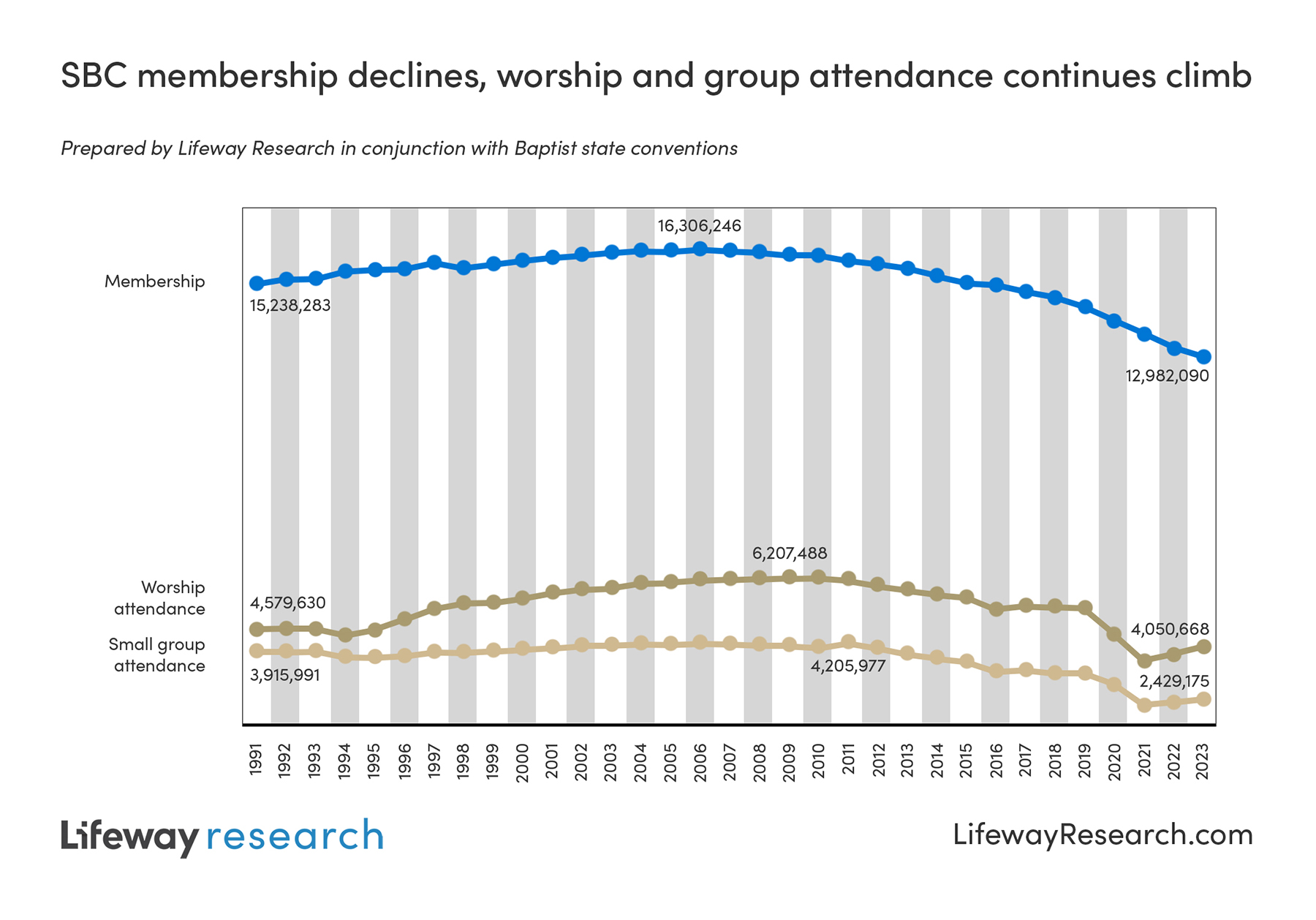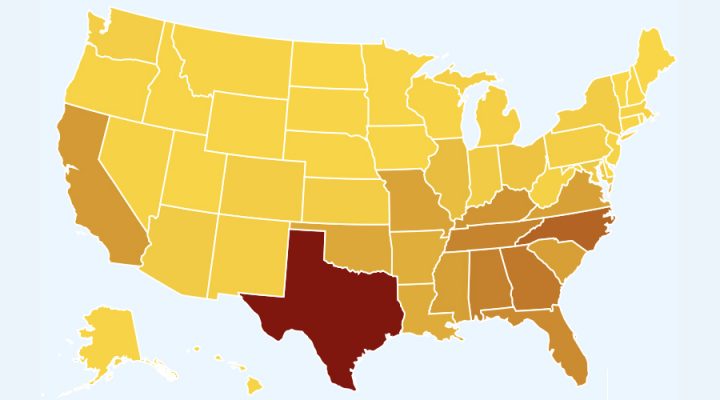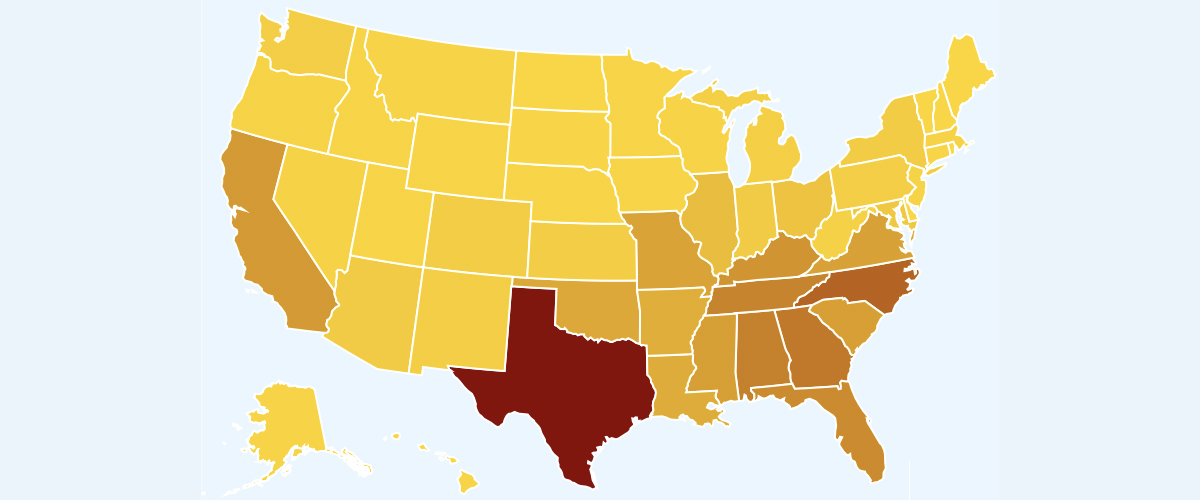The bad news for the Southern Baptist Convention is that membership declined for the 17th consecutive year.
The good news is that last year’s 1.8% decrease was less than recent years.
Those are among findings from the SBC’s Annual Church Profile in 2023. The ACP collects data from the SBC’s 46,906 congregations to create an annual snapshot of key metrics in the nation’s largest Protestant denomination.
Total membership in Southern Baptist-affiliated congregations in 2023 was 12,982,090, down 241,032 from 2022. The three previous years saw declines of 2.9% or more and the 2022 numbers marked the largest single-year decline in a century.
The high point for SBC membership was 16.3 million in 2006, capping decade upon decades of growth since World War II.

In other key measures, baptisms, worship service attendance and small group participation all grew last year but have not returned to pre-pandemic levels.
One of the most troubling trends for the SBC is a continued decline in numbers of affiliated churches and in what the denomination calls “church-type missions,” often known as church starts. That category dropped by 170 to 2,474 in 2023, also continuing a multi-year decline.
The loss in total number of churches and church-type missions keeps multiplying even though the SBC North American Mission Board has turned itself into primarily a church-planting agency spending hundreds of millions of dollars annually on launching and nurturing new churches.
Critics of the agency and its leadership have said for years they do not understand how NAMB can spend substantially more money every year on church planting and continually produce fewer results. This has been a major point of contention between the national agency and state Baptist conventions, which have been cut out of most church-planting partnerships.
The number of church-type missions captured in each year’s snapshot has dropped nearly in half in the past decade alone, with the 2023 number of 2,474 compared to 4,789 in 2013.
This matters because new churches are needed to replace churches that close or leave the denomination each year. Also, younger churches are more likely than older churches to be growing in membership, attendance, baptisms and other key metrics, according to statistical analysis.
Within the SBC, this is not a matter of church plants being labeled as “churches” rather than “church-type missions” because both numbers are declining — following national trends for all churches of all denominations.

At least five of the 50 largest churches in America, as reported by Outreach magazine, are (or were) Southern Baptist. Two of those — Saddleback Church in California and Elevation Church in North Carolina — recently left the SBC because of the denomination’s ban on women serving as pastors and preachers.
If the so-called Law Amendment passes on second reading at next month’s SBC annual meeting, hundreds more churches could leave the denomination or be expelled.
In 2023, the total number of churches associated with the SBC decreased by 292 to 46,906. That’s a small percentage drop but a drop nonetheless, continuing a trend accelerated during the pandemic.
One trend that is growing in the SBC is churches with multiple campuses. The number of “multisite” churches grew by 95 to 680 last year. This corresponds to a trend documented by other national research showing the nation’s largest churches getting larger while smaller churches decline.

As an evangelical denomination, Southern Baptists pay close attention to annual baptism numbers, which reflects the number of people professing faith in Jesus Christ and being baptized, which is required for membership in SBC churches.
Baptisms took a severe hit during the pandemic, likely because churches were not meeting in person and people were cautious about the potential spread of disease through the up-close act of baptism by immersion.
However, that’s not all the story. Baptisms in the SBC had been on a steep downward curve every year since 1999. The 226,000 baptisms reported in 2023 are nearly equal to the numbers reported in 2019 before the plunge of the pandemic.
In-person weekly worship service average attendance exceeded 4 million for the first time in three years. That weekly attendance number is about one-third of the reported membership number.
For context, the average of 4 million people present at SBC churches across the nation on any typical weekend represents only 1.2% of the total U.S. population — and the SBC is the largest Protestant denomination by far. (SBC churches count all ages in attendance, not just adults as some other groups do.)
An estimated 5% of Americans are members of SBC churches, although as population grows and membership numbers shrink, that share of the population also is contracting.
Half of Southern Baptist church members live in five states: Texas (2,461,681), Georgia (1,142,325), North Carolina (989,872), Tennessee (849,306) and Florida (768,437).

Related articles:
In SBC annual statistics, even the good news isn’t that good
SBC’s ‘conservative resurgence’ has brought two decades of baptism declines | Analysis by Mark Wingfield


